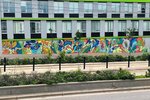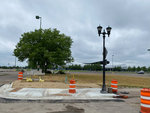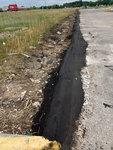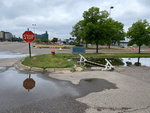















How have businesses in the Midway weathered the dual challenges of the pandemic and racial unrest? Hear from two local leaders, one from the art community and the other from the business community.
Carl Atiya Swanson is the Springboard for the Arts Associate Director.
How was Springboard FOR THE ARTS affected by COVID?
Swanson: We purchased the old Saxon Ford dealership on University Avenue in May of 2018, and held it for a year of pre-development where we hosted lots of meetings, events, and workshops. We broke ground on renovations in August of 2019, and had just moved into our building in February of 2020 – great timing! We were looking forward to being able to finish the building and prepare for opening to the public, and instead, two weeks into being on site, we sent everyone home and began to work remotely.
In that period we saw an enormous upheaval in the arts and creative sector – artists saw their whole year of shows, tours, and workshops disappear overnight. At Springboard we were able to move our core work of supporting artists through workshops, consultations, and resources online and virtual for the most part, and then also moved to respond to the crisis by opening up a Coronavirus Emergency Relief Fund. Through fundraising and generous donors, over the next year and a half we were able to support over 2,600 artists, creative workers and culture bearers with financial support, distributing over $1.25 million in Minnesota. We also created a toolkit for starting an Emergency Relief Fund and convened conversations of people doing this work across the country, supporting a national response in the creative sector.
Throughout the past two and a half years, we’ve been able to continue to support artists with their careers and center artists as essential in vibrant and just economies by supporting creative response projects. We continue to have a high standard of care when it comes to community and health, but we did begin hosting events in our space on University Avenue last year, with an official grand opening celebration in October 2021, and the start of public drop-in hours this year.
How was Springboard affected by the Uprising?
Swanson: In the uprisings following the murder of George Floyd, we did have damage to the building, including a fire that was set. We’re grateful that no one was hurt in the fire, and that we had recently completed renovations that included an up-to-date sprinkler system and fire-retardant carpets, which stopped the damage from being too severe. We were able to work with our insurance company and our contractor partners at Flannery Construction to re-set the building, but it did mean that it was pretty unusable through most of 2020.
One of the unexpected benefit of being closed for that period was that it did allow us to do the exterior renovations without having to work around the building open to the public. With support from the Met Council, Capitol Region Watershed District, and city of St. Paul, we converted an asphalt parking lot into a front yard with lots of green space, rainwater garden and reclamation, a walking circle, and public art. This space is important to us and our vision of more human-centered systems, celebrating creativity, public use, and environmental stewardship.
How has Springboard supported artists and the community as they work to wrestle with racial injustices, the murder of George Floyd, and the pandemic?
Swanson: We focused direct support for artists through the Coronavirus Emergency Relief Fund, and through the consultation, workshop, and resource services that we provide. We have also created a flexible container for artist-led work in community that we call Artists Respond. These Artists Respond projects build on our long practice of artist-led community development work, and allow us to fund artists to take on small, community-centered projects. Immediately following the uprisings, we worked with local district Councils on University Avenue for Artists Respond: On Plywood, supporting artists to create murals on the plywood window coverings on local businesses. Artists Respond: Combating Social Isolation, was a project supporting artists to do work in their communities and bring people together in COVID-safe ways through 2020. The over 80 projects across Minnesota included pop-up concerts, collaborative zines sent by mail, art kits, and online workshops.
In April 2021, we were able to launch our Guaranteed Income for Artists pilot. This pilot sits alongside the People’s Prosperity Pilot in the city of St. Paul, and supports 25 artists in the Frogtown and Rondo neighborhoods with $500 of guaranteed income a month for 18 months. We know that emergency relief is not a sustainable response to the crises we are facing, and we are excited to have artists involved in the nation-wide movement for guaranteed income.
We also have dedicated projects to support artist leadership and community-building. The Creative Community Leadership Institute supports a cohort of 60+ leaders from across Minnesota, North Dakota, South Dakota, and the 23 Native nations that share that geography in building relationships, planning their own community work, and project support. The Rural Regenerator Fellowship is an in-depth, two-year fellowship for 12 creative leaders from rural places across the Upper Midwest. And we have the Creative Economy Fellowship, which is for 10 Black, Indigenous, People of Color, artists and creative community leaders in Minnesota who are building platforms and opportunities for others. Applications for the Creative Economy Fellowship will be opening up in July!
How does art help people work through grief, anger, frustration, and more?
Swanson: Art got us through the darkest days for the pandemic, whether it was our own creativity, connecting through music and movies, or finding ways to connect to others. Artists are often the ones giving voice to the frustrations, challenges, and opportunities of the moment, and one of the things that became abundantly clear in the pandemic was how precarious people’s livelihoods to perform this kind of essential community work really was.
Alongside the direct financial support of the Guaranteed Income pilot, were excited to fund five artists for Artists Respond: People, Place, and Prosperity. This project has shared stories about the impact of guaranteed income in people’s lives, how the funding has reduced stress, how it gives space for creativity and connection, and how it underscores human dignity. The audio stories, videos, sculptures, and coloring books that have come out of this project are a testament to how art helps us grow, heal, and feel connected to each other.
Any other comments?
Swanson: We’d love to host your event! Our Community Hall and Front Yard are available for rental, and we do have an open call for artists to create or host events in the space, that will be open through July 31: https://springboardforthearts.org/262-university-site-use/
Chad Kulas is the Midway Area Chamber of Commerce Executive Director.
How was the Chamber affected by COVID?
Kulas: The Midway Chamber immediately had to pivot all of our events to virtual. We really missed the in-person interactions, but we’ve learned things from the experience. First, we offer some events at hybrid where people can attend in person or virtually. This move has helped some members be able to view the event while they were sick, including myself when I had COVID. We are also continuing on with some events that are only virtual. This way, we can find quality speakers who cannot attend in person.
We also had to watch our financials closely, and our executive committee met weekly for over a year to review numbers and consider our overall planning. Initially, we checked in with members to see how they were adapting and how we could help. We ended up convening meetings on certain topics, like with building managers one time and for people interested in PPP loans twice.
How was the chamber and its members
affected by the Uprising?
Kulas: For many members, they did not see any change to their business or building. But unfortunately, so many were directly impacted. The damage ranged from minor to total loss. The Midway Chamber, along with the Saint Paul Area Chamber and the Saint Paul Downtown Alliance, formed the We Love Midway We Love Saint Paul fund to support those directly impacted. I was really proud of the work done; the fund raised and gave away over $1 million.
Initially, there was also confusion on when businesses were open. We would hear from members their customers were unsure if the area was safe or if hours of operation were changed. By now, most of the boards have been taken off the windows and it is business as usual.
What have local businesses learned through the dual challenges?
Kulas: Businesses learned to adapt. Restaurants and taprooms went to more outdoor seating, delivery options, and touchless ordering. Many businesses realized their employees could work at home and still be productive. I’d say one lesson from both challenges is the strong support they received from loyal neighbors and customers. When some businesses saw complete loss from civil unrest, their decision to reopen was made easier by the strong support they got from others. And early on in the pandemic, many people chose to get takeout more often and from the restaurants they cared about the most. It helped as a business owner if you’d met and built a rapport with some of these customers; it put a face to the business and customers wanted to support them.
In what ways have you seen the Midway, and University especially, challenged during the last two years and in what ways have you seen growth?
Kulas: University Avenue is always changing, and the last two years people have grown more aware of safety. But I’ve also noticed this is a concern everywhere and not specific to our community. Some growths are also seeing challenges. We have seen many new buildings built, including many apartments. This is great as more people can take advantage of life on University, but rent control will make future developments challenging. We’ve seen this in the numbers compared to Minneapolis’ growth.
What new things are on the horizon?
Kulas: I’m excited for more density on University, and also for future developments. I’m excited to see what happens near Allianz Field.
The Midway is one of the most exciting neighborhoods in Minnesota. There is always a vibrancy in it, and things are always changing. The community has a lot of pride and the future should be bright.
Comments
No comments on this item Please log in to comment by clicking here